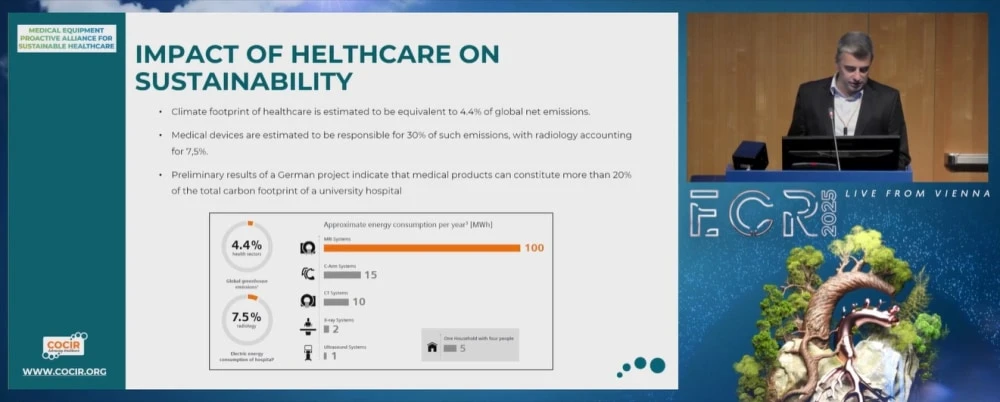The European Congress of Radiology hosted the session "Guiding Radiology to a Greener Future", featuring four experts addressing key sustainability challenges in medical imaging. Their presentations covered green accreditation for radiology departments, preparedness for environmental events, sustainable procurement of imaging devices and reducing water pollution from contrast agents. These insights highlight the urgent need for environmentally responsible practices in radiology and offer practical solutions to minimise the sector’s ecological footprint.
Green Accreditation for Radiology
Sarah Sheard introduced Green ID, a certification scheme aimed at recognising and supporting radiology departments that adopt sustainable practices. Developed by the ESR Sustainability Committee, the programme was designed to move beyond awareness-raising and provide practical tools for departments striving to reduce their environmental impact. The scheme is modelled after similar hospital safety initiatives and includes a structured application process with on-site audits and third-party verification. According to Sheard, the scheme is "bridging the gap from raising awareness to actually giving practical perspective to impact day-to-day clinical practice."
The certification criteria cover multiple sustainability areas, including energy consumption, waste management, procurement and reducing unnecessary imaging. Departments that meet the basic sustainability criteria receive a bronze-level certification, while those demonstrating higher achievements can qualify for silver or gold. The initial pilot phase saw participation from 22 hospitals, offering valuable feedback to refine the certification process.
Sheard also highlighted challenges in adapting the scheme for hospitals of different sizes and regions, ensuring fairness while maintaining strict sustainability standards. The goal is to expand the programme, integrate sustainability into radiology training curricula and provide educational resources to guide departments in their sustainability journey.
Radiology Preparedness for Environmental Events
Kate Hanneman discussed the growing impact of climate change on healthcare and the critical need for radiology departments to prepare for environmental disruptions. She addressed extreme weather events, such as hurricanes, wildfires, floods and extreme heat, as well as less dramatic but equally harmful factors like air pollution and rising temperatures, which increase hospital admissions and imaging demand.
She emphasised that climate change is not just an environmental issue but a healthcare crisis, affecting both patient health and the ability of radiology services to function effectively. Hospitals must prepare for infrastructure damage, IT disruptions and workforce shortages that can arise from environmental crises. "These environmental exposures impact human health and the patients we serve, but they also impact our ability to deliver healthcare more broadly,"she noted.
To build resilience, Hanneman recommended that radiology departments implement disaster preparedness protocols, secure power and data backups and establish emergency response strategies. She also encouraged monitoring imaging volume trends to anticipate surges related to environmental conditions, ensuring radiology teams can adjust accordingly. By focusing on both adaptation and mitigation, hospitals can strengthen their ability to withstand climate-related disruptions and continue delivering high-quality imaging services.
Sustainable Procurement of Medical Imaging Devices
Riccardo Corridori introduced the Medical Equipment Proactive Alliance (MEPA), a collaborative initiative aiming to standardise sustainability criteria for purchasing medical imaging devices. Recognising that radiology equipment accounts for a significant portion of hospital energy use, MEPA focuses on developing eco-friendly imaging technology while ensuring procurement policies align with sustainability goals.
He highlighted that MRI scanners are among the most energy-intensive medical devices, consuming an estimated 100 MWh per year. Through MEPA, manufacturers and hospitals have worked together to develop energy-saving features, such as low-power modes and user-configurable energy settings, which help optimise consumption. Additionally, the initiative promotes refurbishment and life-extension programmes, ensuring equipment is used efficiently before disposal.
To make these sustainability standards widely accessible, MEPA has published a set of 49 sustainability criteria that can be integrated into procurement policies. These criteria address multiple areas, including energy efficiency, material use, chemical safety and corporate ESG performance. By encouraging hospitals and manufacturers to adopt these guidelines, MEPA seeks to streamline sustainability efforts globally, reducing the environmental footprint of medical imaging while ensuring practicality for healthcare providers. According to Corridori, by "developing methodologies to measure the energy consumption, companies were also able to find ways… to reduce the energy consumption."
Reducing Water Pollution from Imaging
Heleen Dekker focused on contrast media pollution, a significant environmental issue due to the widespread use of iodinated and gadolinium-based contrast agents in CT and MRI scans. These substances cannot be completely removed by current water treatment systems, leading to contamination in surface water, groundwater and even drinking water.
"Radiologists have a wide spectrum of options to reduce contrast media use without compromising diagnostic quality,"she noted. She outlined several strategies to reduce contrast media waste, including:
- Optimising contrast administration by ensuring precise dosing based on patient needs.
- Using bulk packaging and multi-patient injection systems to minimise leftover contrast.
- Encouraging contrast collection and proper disposal instead of allowing it to enter wastewater systems.
Dekker presented results from a pilot study where 75% of patients agreed to use urine collection bags after CT scans, preventing contrast media from reaching sewage systems. She also discussed hospital-based filtration systems, which can effectively remove contrast agents from wastewater, providing an innovative approach to pollution control.
Looking forward, she emphasised the importance of collaboration among radiologists, hospitals and manufacturers to implement contrast recycling programmes and invest in new technologies that can help manage contrast media waste more efficiently. By integrating these practices, hospitals can significantly reduce the environmental impact of diagnostic imaging.
As radiology continues to expand, sustainability must become a core priority. From certification programmes and climate resilience strategies to eco-friendly procurement and pollution control, the speakers outlined actionable steps for reducing radiology’s environmental impact. Collaboration across healthcare sectors is essential to drive meaningful change, ensuring that radiology advances not only in technology but also in sustainable practices for a healthier future.
Source & Image Credit: ECR 2025








